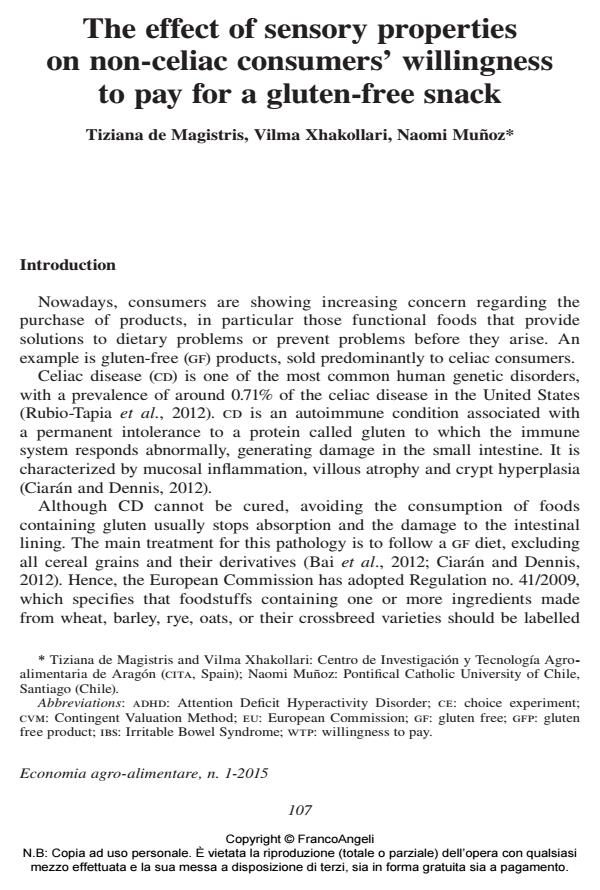The effect of sensory properties on non-celiac consumers’ willingness to pay for a gluten-free snack
Titolo Rivista ECONOMIA AGRO-ALIMENTARE
Autori/Curatori Tiziana de Magistris, Wilma Xhakollari, Naomi Munoz
Anno di pubblicazione 2015 Fascicolo 2015/1
Lingua Inglese Numero pagine 12 P. 107-118 Dimensione file 104 KB
DOI 10.3280/ECAG2015-001006
Il DOI è il codice a barre della proprietà intellettuale: per saperne di più
clicca qui
Qui sotto puoi vedere in anteprima la prima pagina di questo articolo.
Se questo articolo ti interessa, lo puoi acquistare (e scaricare in formato pdf) seguendo le facili indicazioni per acquistare il download credit. Acquista Download Credits per scaricare questo Articolo in formato PDF

FrancoAngeli è membro della Publishers International Linking Association, Inc (PILA)associazione indipendente e non profit per facilitare (attraverso i servizi tecnologici implementati da CrossRef.org) l’accesso degli studiosi ai contenuti digitali nelle pubblicazioni professionali e scientifiche
The aim of our exploratory study is to assess the effects of organoleptic attributes on willingness-to-pay (wtp) values for gluten-free (gf) snacks assessed by non-celiac consumers. This study was undertaken using data from a hypothetical experiment conducted in Spain. We find that non-celiac consumers value the texture of gf snacks and that this is the only attribute to have a significant positive effect on wtp. The descriptive results show that consumers believe that gf products are expensive, but that they do not present secondary effects; they are not considered either a fashion or a fraud. Moreover, the participants followed a healthy diet, which consisted of fruits and vegetables and foods rich in minerals and vitamins.
Parole chiave:Gluten-free, willingness to pay, no-celiacs
Jel codes:C10; C93; D12
- Celiac and non-celiac consumers' experiences when purchasing gluten-free products in Italy Vilma Xhakollari, Maurizio Canavari, in ECONOMIA AGRO-ALIMENTARE 1/2019 pp.29
DOI: 10.3280/ECAG2019-001003 - Recent strategies for tackling the problems in gluten-free diet and products Ilkem Demirkesen, Berrin Ozkaya, in Critical Reviews in Food Science and Nutrition /2022 pp.571
DOI: 10.1080/10408398.2020.1823814 - Why people follow a gluten-free diet? An application of health behaviour models Vilma Xhakollari, Maurizio Canavari, Magda Osman, in Appetite 105136/2021 pp.105136
DOI: 10.1016/j.appet.2021.105136 - Conceptualizing “free-from” food consumption determinants: A systematic integrative literature review focused on gluten and lactose Mariarosaria Savarese, Wendy Wismer, Guendalina Graffigna, in Food Quality and Preference 104170/2021 pp.104170
DOI: 10.1016/j.foodqual.2020.104170 - Are gluten-free products healthy for non-celiac consumers? How the perception of well-being moderates gluten-free addiction Cristina Zerbini, Francesca De Canio, Elisa Martinelli, Beatrice Luceri, in Food Quality and Preference 105183/2024 pp.105183
DOI: 10.1016/j.foodqual.2024.105183 - Celiac Disease and Non-Celiac Gluten Sensitivity Tiziana de‐Magistris, Hind Belarbi, Wajdi Hellali, (ISBN:978-953-51-3177-9)
- Factors affecting consumers' adherence to gluten-free diet, a systematic review Vilma Xhakollari, Maurizio Canavari, Magda Osman, in Trends in Food Science & Technology /2019 pp.23
DOI: 10.1016/j.tifs.2018.12.005
Tiziana de Magistris, Wilma Xhakollari, Naomi Munoz, The effect of sensory properties on non-celiac consumers’ willingness to pay for a gluten-free snack in "ECONOMIA AGRO-ALIMENTARE" 1/2015, pp 107-118, DOI: 10.3280/ECAG2015-001006